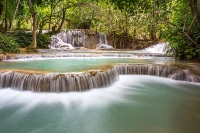
Tourists frequently rate the multi-tiered Kuang Si Falls as the top attraction in Luang Prabang. The serene location sees turquoise-green water tumble over a series of limestone terraces and collect in lovely pools, all of which are surrounded by lush greenery. Walkways lead around the base and to the summit, and visitors will find many places to picnic. The swimming is glorious, with rocks, branches and rope swings providing fun ways to enter the water. Given their natural splendour, it's no surprise that the falls get crowded. Travellers should visit as early as possible to fully appreciate the location and take good photographs. The falls are about 18 miles (29km) south of Luang Prabang.
Transport : Hire a motorbike or tuk-tuk and driver for the day. Motorbikes usually cost more for the day than tuk-tuks, and the latter can accommodate up to four passengers. It is possible to bargain with the drivers and get a better deal.
Admission : A small fee of about $2 is sometimes asked of visitors.
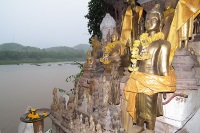
The Pak Ou Caves lie about two hours away from Luang Prabang and are only accessible by boat. They tend to divide opinion among visitors. Some find the area to contain an intriguing spiritual power, while others don't see what all the fuss is about. Most agree that the scenic boat trip to the caves is fun and worthwhile. The lower and upper caves contain and an impressive collection of mostly wooden Buddha statues, which locals and pilgrims have assembled over the centuries. Hundreds of pilgrims journey to the caves every year, adding new statues to the gallery. The collection contains some unusual specimens, many of which are hard to reach. Visitors will need a flashlight to climb the stairs leading to the upper cave. The lower cave is visible from the river. Photos are permitted and visitors often light candles as tributes. Many tourists combine trips to the caves with visits to the villages along the river banks or activities like elephant riding.
Transport : Boat from Luang Prabang
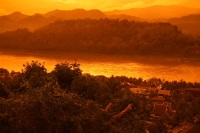
Phou Si is a hill near the confluence of the Khan and Mekong rivers. Many visitors use it as a navigation landmark, as it's visible all over town. The hill is also home to several caves, small temples and Buddha images, and offers spectacular views of Luang Prabang from its summit. Visitors will find the city's oldest temples on the lower slopes, though the area's most prized spiritual structure is the golden stupa of That Chomsi. Indeed, it has become a symbol of Luang Prabang's spiritual significance to Laos. Travellers reach the stupa by climbing 300 steps and passing various temples and shady trees along the way. Early morning visits are especially worthwhile, given that the temperature is cool and the temples are at their most active. Sunset trips are also tremendous, though tourist crowds tend to visit around this time of day, making the overall experience less serene. The climb is a bit easier from the back of the hill, where a trail winds upwards and there are only about a hundred steps, rather than 300-plus. Some of the most interesting Buddha statues can be found via this back entrance. Climbing up one way and down the other would allow visitors to appreciate all the hill's sights and views. Travellers visiting in the evening can stop at the night market, which they'll find in front of the Old Palace at the foot of Phou Si.
Located in the Xieng Khouang Plateau of Northern Laos, the mysterious Plain of Jars is an unusual sight and a must-see attraction. Visitors will find hundreds of huge stone jars scattered about the landscape, some weighing as much as six tonnes and measuring around six feet in length. They're believed to be over 2,000 years old, though their origin and original function remain unknown. The gaps in their narrative have allowed for many theories and legends to develop. One story claims they were made to ferment rice wine to celebrate a victorious battle against a wicked chieftain in the 6th century. Other theories have them as sarcophagi or funerary urns. The jars are clustered into 90 groups, with Thong Hai Hin, or Site 1, being the largest and most easily accessible site. Only Sites 1, 2 and 3 are open to visitors, as unexploded mines from the war lie around the other locations. Many guesthouses in the town of Phonsavan offer tours to the sites. As a precautionary measure, town visitors should stop at the Mines Advisory Group (MAG) and learn about the clearing of unexploded bombs in the area and throughout Laos. The site is situated several kilometres southeast of Phonsavan, which is a 30-minute flight from Luang Prabang. Travellers interested in visiting can hire a driver and either a 4X4 or a small tuk-tuk for the day. More adventurous visitors can hire a motorbike and drive out themselves. Sites 1 and 2 are well signposted and 3 is easy enough to find. The drive from Phonsavan is scenic and the people living along the road are generally friendly and helpful.
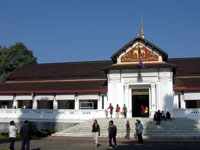
The former Royal Palace is a mixture of French and Lao architecture, and is now a museum. It preserves the monarchy's possessions and has one of the glitziest interiors around. A three-headed elephant sheltered by the sacred white parasol sits above the entrance, and is the symbol of Lao's monarchy. All things considered, the Throne Hall is the most impressive room in the complex. The dazzling interior comprises mirrors, mosaics, and displays of royal regalia that include glittering swords and the former King's elephant saddle. The Pha Bang (delicate Buddha) is the museum's most prized item, and is housed in a small, barred shrine that was the King's personal sanctum. Believed to have been crafted in the heavens, it is the country's most sacred image and spiritual protector. The museum has information in Lao and English but is worth visiting with a local guide, who can share myths and legends as well as history. Shoes and bags must be left at the entrance. Photography is not allowed.
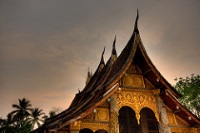
Situated at the tip of Luang Prabang's peninsula, the Golden City Temple is the country's most enchanting monastery and perhaps its most talked-about tourist attraction. Its grandest feature may be the graceful, sweeping tiled roof of its main temple, though the stencilled gold designs on its walls are marvellous too. The latter depict many traditional tales. At the rear, visitors will find a splendid coloured-glass mosaic illustrating the 'tree of life'. The compound garden's peaceful atmosphere features several shelters, which house rare Buddha images and the gilded royal funerary carriage. From a tourism perspective, general consensus is if visitors can only explore one of the country's monasteries, is should be Wat Xieng Thong. Travellers should bring a guide book or hire a local guide before visiting. That way, they can fully appreciate the temple and its history. Evenings see the light reflect beautifully off the glass and gold of the walls, while the monks are called into prayer by drums.

Travel Guide powered by Word Travels, copyright © 2023 Globe Media Ltd. By its very nature information in this travel guide is subject to change at short notice and travellers are urged to verify information on which they're relying with the relevant authorities. Neither Globe Media Ltd nor Travel Vogue can accept any responsibility for any loss or inconvenience to any person as a result of information contained above.